Infrared thermal imagers can help firefighters conduct reconnaissance, search and rescue, and firefighting at disaster sites by using infrared thermal imaging technology. Whether it is a fire accident or a rescue accident, thermal imagers can give firefighters a vision beyond the naked eye, becoming an important tool for professional firefighters to rescue. Firefighters who are proficient in using infrared thermal imagers can improve the efficiency of firefighting and rescue, predict risks and hidden dangers, and ensure the safety and efficiency of firefighting and rescue operations.
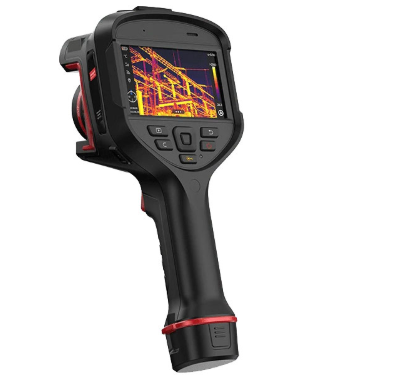
Basic knowledge of infrared thermal imagers
1. Working principle
In nature, all objects with a temperature higher than zero degrees (-273℃) will radiate heat at all times. This radiant heat is radiated outward in the form of infrared electromagnetic waves. This infrared radiation can characterize the characteristic information of the object, such as the temperature. Infrared thermal imagers use this feature. Infrared thermal imagers convert the power signal radiated by the heating part of the object into an electrical signal through a photoelectric infrared detector, and then process the converted electrical signals one by one through an imaging device and convert them into image signals and transmit them to the screen, so as to obtain a thermal image corresponding to the heat distribution of the object, which is the infrared thermal image we see.
The imaging principle of infrared thermal imaging determines the shortcomings and deficiencies of infrared thermal imaging. Mastering this principle can help firefighters understand the defects of the instrument.
2. The structure and mode application of thermal imaging
The firefighting infrared thermal imager consists of five components: optical system, infrared detector, amplifier, signal processor, and display. In order to facilitate firefighting applications, general firefighting thermal imagers have the characteristics of explosion-proof, heat-resistant, waterproof, drop-proof, and lightweight.
In order to better adapt to the application of firefighting and rescue, many thermal imagers currently have multiple imaging modes. The purpose is to better use them in different application environments. Taking Mi-TIC-320-3-C handheld infrared thermal imager as an example, this thermal imager has a total of 6 imaging modes:
① Fire mode: Generally used for fire fighting and rescue inside buildings. The characteristic of this mode is that when the temperature is higher than 150℃, the phenomenon of the object will be colored, so as to more clearly judge the temperature of the object within a certain range. The coloring is fixed, and the image details are kept visible throughout the range by changing the brightness and color.
②Evaluation mode: Generally used for reconnaissance and evaluation outside the fire scene. This mode is different from the fire mode in that it lowers the temperature of the image coloring. Within the limited dynamic range of 250℃, the temperature color reference is divided into 5 scales, so that the high temperature area and the location of the fire point can be quickly judged from the outside.
③White-hot mode: This mode is mainly used for searching for heat sources in scenic spots, buildings or traffic accident sites. This mode does not distinguish the temperature phenomenon by color, only contrasts white-hot and black-cold, and has a limited dynamic range reference bar from -40℃ to 80℃. There is no temperature mark, and the image details are kept visible in the entire range by changing the brightness.
④Search mode: It can be used to search for heat sources and high-temperature objects. The main feature is that the objects with the highest temperature in the environment are highlighted in red, which is conducive to the search personnel to locate the high-temperature objects in the environment in time.
⑤Inspection mode: It is mainly used for maintenance inspection of equipment, such as querying the load status of electrical equipment. The feature of this mode is that it displays the phenomena of different temperatures in full color scale, and can clearly see the color differences of different temperatures.
⑥ Search and rescue mode: This mode is generally used to search for trapped people inside buildings that have not been burned. The characteristics of this mode are that in an environment without fire, the blue and high-contrast images are used to highlight the heat source, increasing the probability of search and rescue discovery.
Application of infrared thermal imagers in rescue scenarios
The infrared thermal imaging instrument is mainly used in the following aspects in fire rescue applications:
1. Fire reconnaissance
Reconnaissance mainly determines the source point and spread path of heat generated by combustion, so as to determine the room where the fire first ignites, the specific location of the fire point, the direction of fire development and spread, etc., so as to determine the stage of fire development and the path of fire attack. Fire reconnaissance generally uses the evaluation mode.
1.1 Determine the room where the fire first ignites
After a residential fire occurs, due to the influence of building separation, the combustion will be temporarily confined to the room where the fire first ignites. As the combustion continues, the fire breaks through the doors and windows and spreads to other rooms. Since the room where the fire first ignites has the longest burning time, burns the most fully, and has the highest indoor temperature. Therefore, by using infrared thermal imagers to image the outside of the building in real time, the room where the fire first ignites can be roughly determined.
1.2 Determine the direction of fire spread
Generally speaking, the direction of fire smoke spread is the direction of fire spread. Since fire smoke has the characteristics of high temperature and high heat, the direction of fire spread can be roughly determined by observing the flow direction of fire smoke through the real-time imaging characteristics of thermal imagers, and the pressure distribution and smoke driving form inside the fire scene can be roughly determined to prevent firefighters from fighting in the smoke flow path.
1.3 Determine the starting point of the fire
The judgment of the starting point of the fire is very important. Generally, the indoor walls and ceilings at the starting point of the fire are the highest points of the temperature inside the entire building, which can be used to determine the approximate location of the fire point.
2. Use of firefighting and rescue inside the fire scene
Infrared imagers can provide firefighters with a clear view in dense smoke or low visibility environments, and more conveniently observe the environment inside the fire scene. Inside the fire scene, there are mainly searching for trapped people, finding hidden fire points, auxiliary jet cooling, and finding escape exits.
2.1. Search and rescue trapped people
Infrared light can penetrate hot smoke, and the temperature difference between trapped people and the surrounding environment at the fire scene can be utilized. Infrared thermal imagers display different temperature distribution maps, which can enable firefighters to clearly find trapped people in thick smoke conditions and win precious time for rescue. Research data shows that at indoor fire scenes under the same hot smoke conditions, the time for search and rescue using infrared thermal imagers can be reduced by 80% compared to the time for search and rescue without infrared thermal imagers.
2.2 Finding hidden fire points
In building fires, because there are many hollow gaps in the building, such as ceilings, insulation wall cavities, and elevator cable shafts, when a fire occurs, the fire point is often not easy to be found. There are hidden burning and smoldering situations, and re-ignition may occur if you don't pay attention. At this time, the fire and inspection mode can be used to quickly locate the hidden fire point and accurately strike the fire point.
2.3 Auxiliary jets
Infrared thermal imaging can clearly see the heat energy distribution in the building. According to the field of view of thermal imaging, high-temperature objects, accumulated high-temperature smoke, burning fire sources, etc. can be identified, so that limited fire extinguishing agents can be applied to the places where cooling is most needed, improving the efficiency of fire fighting and rescue, and reducing water damage inside the fire scene.
3. Non-fire rescue applications
3.1 Traffic accident rescue applications
In vehicle accident rescue, especially at night, the white-hot mode can be used to find hidden leaks, such as fuel, hazardous chemicals, etc.; determine the scope and size of the scene, including the number of designed vehicles and the positions of personnel and vehicles in low visibility conditions such as snow, fog, etc. at night. In addition, the location of rescue personnel can be determined in low visibility conditions to ensure safety control on site.
3.2 Outdoor search and rescue
Since thermal imagers can detect the heat generated by the human body, searchers can use thermal imagers to find trapped people faster through obstacles. The search and rescue mode can expand the difference between human body temperature and ambient temperature outdoors, so the search and rescue mode should be selected for outdoor searches.
3.3 Electric load monitoring
Wires will heat up under high load conditions. Power department staff often use the inspection mode to detect the load heating of wires or electrical equipment to control risks in a timely and safe manner.
3.4 Determine the location of the leak
Liquid or high-pressure gases absorb heat when they are gasified or leaked, causing the temperature at the leak point to drop sharply. The low-temperature gas will condense the water vapor in the surrounding air, causing the surrounding vision to be blurred as if there is a thick fog. In addition, in this case, firefighters generally wear heavy protective equipment, which reduces their auditory and visual observation capabilities. At this time, the infrared thermal imaging instrument can display the surrounding temperature difference on the screen through the mist, so the infrared thermal imager can be used to quickly find the specific location of hidden leaks caused by valve damage, pipeline rupture or other related equipment damage.
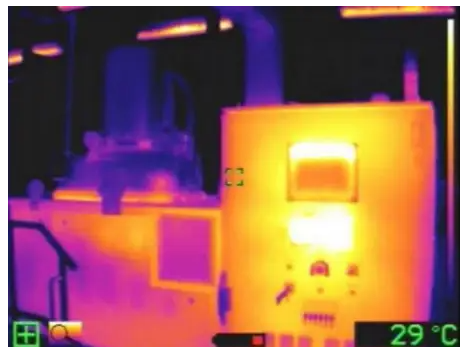
4. Tank capacity detection
When the oil tank without insulation layer and other tank bodies are subjected to thermal radiation, the temperature difference will be generated because the heat capacity of the material in the tank is larger than that of the empty tank. The thermal imager can easily determine the liquid level of the liquid storage tank. It is also possible to detect the liquefied gas cylinders in the tank truck and the fire scene to determine whether the dangerous source is explosive. Special disaster sites such as petroleum and chemical industries have become high-risk disaster rescue sites because of the large number of flammable storage tanks. In this type of enterprise fire, the data collection of tank temperature and liquid level is particularly important for commanders to make decisions. The naked eye cannot directly see the specific liquid level of petrochemical products and raw materials in the tank. However, when these liquids are stored in the tank, there will be a certain temperature difference because the heat capacity of the stored flammable liquid is larger than that of the empty tank area.
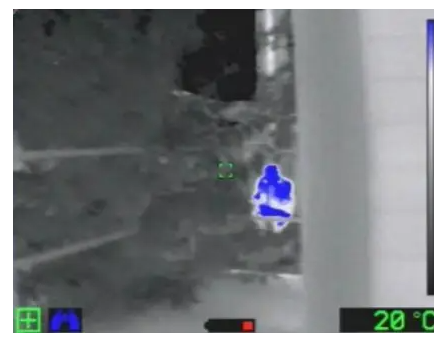
Limitations and influencing factors of the use of infrared thermal imagers
1. Reflection of infrared rays
For objects with smooth surfaces, such as glass, metal doors, and water on the ground, the infrared energy of the surrounding environment or objects will be reflected by the smooth surface, and the image of reflected infrared rays may be seen when using thermal imaging.
2. Penetration rate
Some objects that can be penetrated by visible light may not be penetrated by infrared rays, such as glass or transparent film.
The infrared energy behind the transparent glass window cannot penetrate the glass, and the thermal imager can only display the outdoor environment where the window is open. On the contrary, the red line energy of the user in front of the glass window is reflected and presented in the display video of the thermal imager.
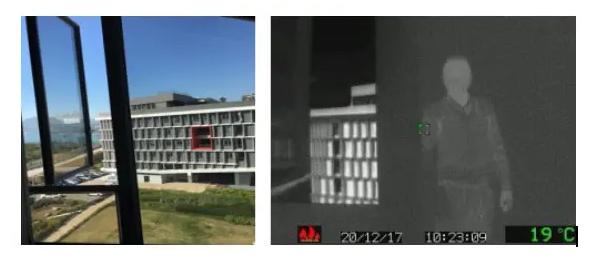
3. Field of view
The visual range of the human eye is about 200 degrees horizontally and 135 degrees vertically, while the general thermal imager has only 50 degrees horizontally and 37.5 degrees vertically. This results in the infrared thermal imager's field of view being only 1/4 of the human eye's field of view. The narrow angle allows the user to mistakenly judge that the place or object under observation is closer or larger in size, and what is actually seen is farther or smaller.
4. Relative temperature
Whether an object becomes brighter or darker in the infrared thermal imager's picture depends on the relative temperature of the object in the environment. Therefore, in search and rescue, assuming that a person is in a fire scene, the relative temperature of the human body is lower than that of the fire scene, so the image of the human body is relatively dim. If the person is actually outdoors, the human body temperature is relatively high relative to the outdoor temperature, and the image of the human body is relatively bright.

5. Temperature measurement
Some thermal imagers can read the temperature of the scene and display the temperature of the surface of the material at the central mark point. However, since the infrared thermal imager receives infrared rays indirectly from the outside and calculates the surface temperature of the relevant object, this kind of temperature measurement without direct contact is easily affected by many factors and cannot be used as an accurate temperature reading. It can only be used as a reference. When measuring temperature, you should pay attention to the following aspects to improve the accuracy of temperature measurement.
The following example uses a water bottle filled with hot water as a demonstration.
5.1 Measurement distance: When infrared rays propagate in space, they may be affected by substances in space, such as water vapor, smoke, etc., resulting in heat loss. It is recommended that when the thermal imager measures temperature, the distance between the measured object and the instrument should not exceed 4 meters. The measured temperature is only the surface temperature of the measured object, which is not equal to the actual temperature of the substance. When the distance is close, the actual temperature of the object can be accurately obtained, but due to the imaging of the infrared imager, it is difficult to judge the shape of the object or the overall environment. Therefore, if you need to use an infrared thermal imager to measure temperature, you should measure at a closer distance.
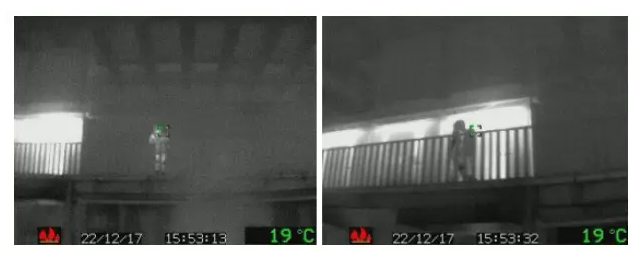
The following is a comparison of the situation of testing a thermos bottle at a close distance and testing a thermos bottle at a long distance. (For accurate temperature, measure at close range; for clear imaging, measure at long distance)
5.2 Measurement angle: If the object to be measured is not in the same horizontal direction as the infrared thermal imager, the propagation distance of infrared rays will increase and the temperature loss will be greater. Therefore, when measuring the temperature of an object, try to keep it in the same horizontal direction as the object.
5.3 Measurement position: The infrared thermal imager only reads the average temperature of the object position marked by the target in the center of the display screen. When measuring an object, the user must ensure that the mark in the center of the display screen is aimed at the object and the central mark is completely covered.
Differences in marks at different positions when measuring horizontal
5.4 Size of the object to be measured: If the area of the object to be measured is small, the temperature of the object measured by the thermal imager will be more disturbed by the temperature of the surrounding materials. It is recommended that the object to be measured should occupy at least one-third of the screen of the thermal imager display.

5.5 Environmental factors: If the on-site environment is filled with a lot of water vapor or the infrared thermal imager lens has water vapor or other pollutants, it will reduce the intensity of the infrared energy received by the thermal imager. When using it, you should avoid the situation of a lot of water vapor and keep the mirror of the infrared thermal imager clean.
5.6 Material of the measured object: Compared with other materials, metal materials emit less infrared energy at the same temperature, resulting in a significant decrease in temperature readings. Smooth-surfaced materials may also reflect infrared rays from the surrounding environment, so thermal imagers cannot effectively measure the infrared energy emitted by metal objects themselves.
5.7 Material interference or shielding. Infrared rays cannot penetrate glass, metal, and stagnant water. The temperature after measuring the above materials will be shielded. Other thicker materials, such as walls and quilts, will also interfere with the measurement, resulting in unclear images of the materials on the display screen.

Infrared thermal imagers can bring firefighters a vision that is invisible to the naked eye, which can greatly enhance the efficiency, flexibility and safety of firefighting and rescue operations. However, if the technical limitations of infrared thermal imagers are not fully understood, it may cause misunderstandings in the interpretation of images, or even cause danger. Therefore, firefighters are equipped with infrared thermal imagers during daily drills. Observing the images of the display in different situations helps to strengthen the judgment of pictures, objects, distances, space sizes and intervals, so that they will be more confident and handy in actual use.


